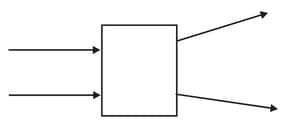A lens may have two spherical surfaces, bulging outwards. Such a lens is called a convex lens. It is thicker at the middle as compared to the edges. A concave lens is bounded by two spherical surfaces, curved inwards. It is thicker at the edges than at the middle. Answer the following question.
The nature of images formed by two lenses are given.
(i) An erect and magnified virtual image
(ii) An erect and diminished virtual image
By using which type of lens will we get an image having the same size as the object?
(i) An erect and magnified virtual image
(ii) An erect and diminished virtual image
Important Questions on Light
A student wants to obtain magnified image of an object AB as on a screen. Which one of the following arrangements shows the correct position of AB for him/her to be successful?
A converging lens forms a three times magnified image of an object, which can be taken on a screen. If the focal length of the lens is , then the distance of the object from the lens is _____.
If a lens can converge the sun rays at a point away from its optical centre, the power of this lens is _____.
An object is placed at a distance in front of a convex lens of focal length .
(i) Calculate the distance of the image from the lens.
(ii) Calculate the magnification of the image.
The following diagram shows the use of an optical device to perform an experiment of light.

As per the arrangement shown, the optical device is likely to be a _____.
A person can not clearly see objects at a distance more than 40 cm. He is advised to use lens of power
A virtual, diminished image is formed when an object is placed between the optical centre and the principal focus of a lens.
(i) Name the type of lens which forms the above image.
(ii) Draw a ray diagram to show the formation of the image with the above stated characteristics.

